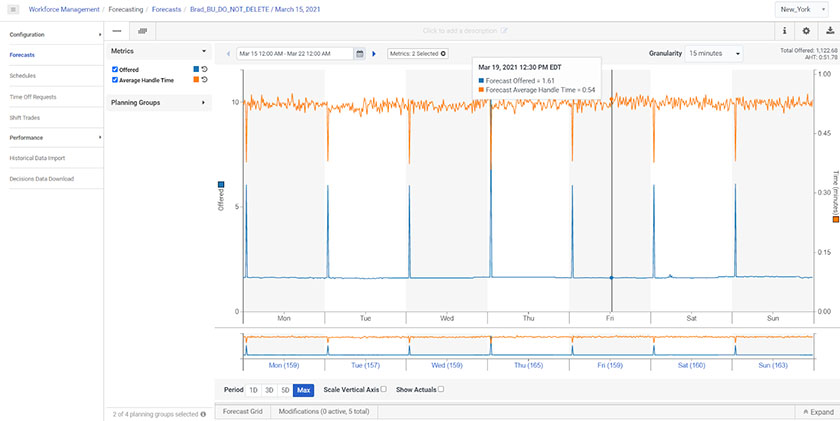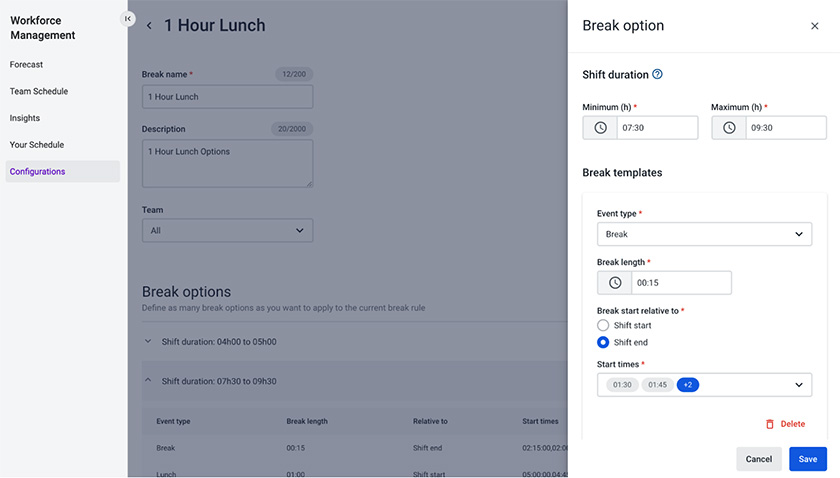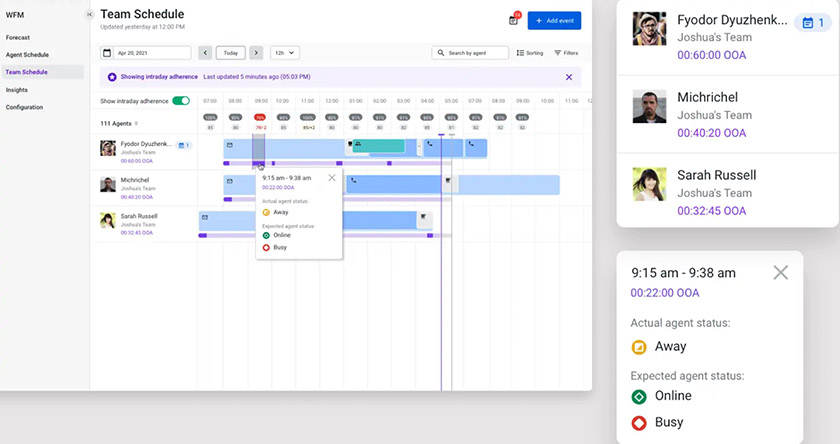Contact center workforce management (WFM) is a set of processes that ensures the right number of agents with the right skill sets are available at the right time. It has four components: forecasting interaction volume, optimizing agent schedules, assigning agents to shifts, and managing intraday activity. When done right, WFM boosts agent engagement and customer satisfaction. Keep reading to determine the role of workforce management in contact centers.
Key Functions of Contact Center Workforce Management
Call center workforce management has four building blocks—forecasting, scheduling, agent assigning, and intraday management. To understand what workforce management is in a call center, let’s examine each component and how it works.
Forecasting
Forecasting involves calculating the expected number of incoming calls in the coming days, weeks, or months to determine the number of agents needed. It draws from special events, upcoming holidays, and historical data (e.g., contact patterns and volume trends) to predict future workload and staffing needs. This helps contact center managers determine if enough agents are scheduled to manage call traffic during peak periods.

Genesys Cloud’s workforce management forecast displays the expected number of interactions in succeeding weeks.
(Source: Genesys Cloud)
An omnichannel contact center software like Genesys Cloud has a built-in workforce management tool that records every customer interaction for accurate forecasting. It collects historical data from phone calls, live chats, text messages, and emails and analyzes the collected data to search for trends and patterns.
Scheduling
Once forecasting is done, the next step is to use the data drawn from the forecast to determine the shifts and hours that will need coverage. Scheduling involves matching agents with the services and campaigns that align with their skill sets, calendar items, and contracted work rules. For instance, agents with sales skills are scheduled during promo runs to convert more callers.

Talkdesk lets you define the schedule of agents’ breaks within a shift. (Source: Talkdesk)
Scheduling can be simplified with artificial intelligence (AI)-powered WFM software like Talkdesk. It uses automated skill-based scheduling to assign agents best suited for the job. When scheduling is planned right, agents can deliver their tasks successfully and improve first-call resolution and overall customer service.
Agent Assigning
After scheduling, it’s time to assign the right number of agents to their shifts. The delicate part of this process is to balance your operational needs with agent experience and preferences. When distributing agents to specific shifts, it’s important to consider their expertise, experience, performance, and time-off requests.
Proper assignment of shifts ensures agents remain productive and engaged without getting burned out. In this case, you might want to apply “shift bidding,” where employees can select the work shift they prefer or request a shift they qualify for. This empowers agents to choose shifts that work for them. However, this method requires consideration of the agent’s length of service and call handling ability.
Intraday Managing
A contact center is a fast-paced environment, which means anything can happen at any time. Such changes may vary from sick leaves, weather disturbances, and sudden spikes in call volume. This is where intraday management comes in to help call centers respond to changing conditions by shifting staffing allocations and reassessing workforce priorities to meet service-level goals.

Talkdesk allows users to apply intraday adjustments on the fly. (Source: Talkdesk)
Talkdesk offers an intraday reforecasting feature with live updates so users can proactively respond to unexpected call volume changes. Intraday managing involves reallocating staffing resources so agents and teams can keep up with the shifting conditions. For managing inbound calls, intraday activities may include facilitating self-service options, adding more staff, and routing calls to available agents.
Benefits of Contact Center Workforce Management
Managing a contact center is complex and demanding due to the many aspects involved, particularly in managing human resources. This is where workforce management comes into play to help balance agent workload, maximize productivity, and reduce operational costs. Below we outline the benefits of having a dedicated contact center workforce management software.
- Increases cost savings: Labor in contact centers consumes a significant portion of its operational costs. With WFM tools like data analysis and forecasting, you can minimize the pains of understaffing and overstaffing by balancing agent availability and customer demand. This also opens up revenue opportunities by maximizing the individual contributions of agents.
- Boosts agent engagement: The data provided by workforce management contact center solutions empowers supervisors to assign agents to tasks based on their skills, allowing them to be more productive and efficient. Also, balancing agent workloads creates a positive impact on employee morale by assigning them to areas where they perform the best, thereby avoiding burnout and achieving work-life balance.
- Improves customer satisfaction: Proper workforce management reduces call handling time because agents are assigned to roles based on their skills. For instance, agents provide quicker resolutions because they have the expertise to handle the customer’s inquiry. WFM also minimizes call waiting time as it ensures the right number of agents are available to handle high call volumes. This translates to improved customer experience due to accurate and timely assistance.
- Simplifies data handling: Manipulating data in spreadsheets is a manual process, which is inherently prone to human error. WFM software uses an integrated system that records and analyzes call center metrics. Besides improving efficiency, contact centers get detailed insights about proper operational processes and make adjustments as needed.
Top Providers of Contact Center WFM Software
Finding the right contact center workforce management software for your business involves careful consideration of various factors. These include the pricing, feature requirements, scalability of the platform, and compatibility with your company’s existing system. To help you with your buying decision, here’s a breakdown of the top call center phone systems with built-in workforce management capabilities:
Contact Center WFM Software Providers | Monthly Starting Price (per User) | Key Features | Learn More |
|---|---|---|---|
 |
| ||
 | Custom pricing |
| |
 | $71 |
| |
 |
| No Review Yet | |
 | $75 |
| No Review Yet |
Are you seeking a small business-friendly communication platform without the comprehensive features of contact center software? Our guide about voice-over-internet-protocol (VoIP) phone systems provides everything you need to know about this cloud telephony solution.
Frequently Asked Questions (FAQs)
WFM software promotes regulatory compliance by providing oversight and proper management of employee records. It also helps contact centers avoid compliance risks by keeping track of labor-related data, such as timecards, overtime, and paid time off.
WFM is highly suitable in contact centers where high volumes of customer inquiries come in regularly. The use of WFM software helps managers make better staffing decisions by accurately forecasting the number of calls and assigning the right number of staff with the appropriate skills.
Yes. Modern omnichannel contact centers like RingCentral and NICE CXone provide WFM tools that work across various customer service channels, such as phone calls, live chat, and email. These providers feature multi-channel staffing forecasts to help you assign more agents to channels experiencing a higher demand.
Bottom Line
Understanding what contact center workforce management is enables companies to manage their team of agents effectively and efficiently. WFM is all about allocating the appropriate agents when and where you need them and ensuring employee productivity is maximized.
If you’re looking to enhance operational efficiency and customer service, investing in a contact center WFM software offers a one-stop solution for a seamless agent and customer experience.